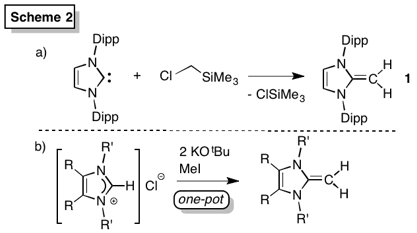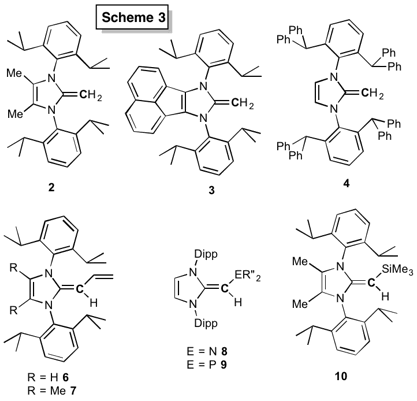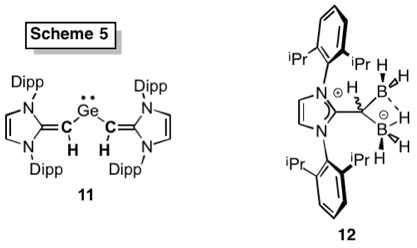Reports: ND354954-ND3: N-Heterocyclic Olefins (NHOs) as Tunable Ligands for Metal-Mediated Catalysis
Eric Rivard, PhD, University of Alberta
During the first half of our PRF supported project, efficient routes to an emerging class of carbon-based donor, termed by us as N-heterocyclic olefins (NHOs), have been developed. With this library of a dozen new NHO ligands, we have been exploring palladium-catalyzed cross-coupling protocols for C-C and C-N bond formation. An added bonus of this work has been the discovery of a main group element (boron) based hydroborylation catalyst.
NHOs have been known since the early 1990s[1] and due to the presence of a highly polarized exocyclic double bond, these species can act as Lewis bases (Scheme 1). After our group's use of NHOs to stabilize low-valent main group compounds (e.g. GeH2) in 2011,[2] about a dozen groups now investigate NHOs, including as organocatalysts.[3] Thus our new ligands outlined herein should have impact outside the initial target domain of catalysts.
Phase 1a: Monodentate NHOs
To facilitate the future use of NHOs in catalysis, improved syntheses were established. The most studied NHO IPrCH2 [1, IPr = (HCNDipp)2C:, Dipp = 2,6-iPr2C6H3] is now obtained on a ca. 20 g scale by combining the free carbene IPr with ClCH2SiMe3 (Scheme 2; PRF publication; Powers et al.). A general one-pot synthesis of a wide range of NHOs was achieved (Scheme 2b), including those with backbone Me groups (2), and ¹-extended systems (3, Scheme 3). As hindered donors perform best in cross-coupling, the exceedingly bulky NHO, IPr*CH2 (4) (Scheme 3) was also prepared.
Bicyclic NHOs with alkane rings fused at the terminal carbon donor sites were synthesized (5, Scheme 4). These donors have steric bulk directly at the site of ligation. As in Buchwald's diarylphosphine ligands, there exists the possibility for stabilizing secondary aryl group---metal interactions within 5 (Scheme 1).
Phase 1b: Bidentate NHOs
Bidentate NHOs were also prepared, including the butadiene analogues 6 and 7 (Scheme 3). These ligands are conceptually related to the widely used allyl ligands, such as cinnamyl (Cin), found in highly active Pd pre-catalysts. We also just published a report (Dalton Trans.; Paisley et al.) that features NHO units fused to both hard amine (-NMe2) and soft phosphine (-PPh2 and –PiPr2) donors (8 and 9, Scheme 3). The idea is to access to hard/soft donor combinations to stabilize various metal oxidation states found in catalysis.
Phase 1c: Added developments
Deprotonation of a =CH2 terminated NHO, e.g. IPrCH2, would afford an anionic species with possible dual s and ¹-donating abilities. As shown in Scheme 5 two anionic NHO units were installed onto Ge to give a linear two-coordinate germylene (11) stabilized by added ¹-electron donation from the (IPr=CH)- ligands. A similar strategy could be easily applied to obtain high oxidation state transition metal complexes. This study was recently submitted as a communication to Angewandte Chemie. The cyclic borane (IPrCH)B2H5 (12) was also prepared and shown to be a highly active catalyst for the borylation of ketones (0.5 mol % loading; Scheme 5), due to the presence of hydridic (-BH3) and Lewis acidic (-BH2) sites. This is a rare example of main group element instigated catalysis.[5]
Phase 2: Donor Properties of NHOs
We also prepared various NHO Pd(II) complexes with representative examples shown in Scheme 6. Dimeric complexes [(NHO)PdCl2]2 (e.g. 14) were obtained directly from [PdCl2(NCPh)2] and NHO, while known procedures were also used to prepare the active catalyst [(IPrCH2)PdCl(Cin)] (15) and PEPSI analogues such as [IPrCH2)PdCl2(3-chloropyridine)] (16); such complexes with NHCs as ligands have been shown to be highly effective pre-catalysts in Buchwald-Hartwig and Suzuki-Miyaura cross coupling protocols.[6]
The Tolman Electronic Parameters (TEPs) of our NHOs was determined via IR analysis of the Rh(I) complex [(IPrCH2)RhCl(CO)2] (17). As shown in Table 1, the comparatively low avg. ν(CO) value found for 17 initially suggests that NHOs are better donors than NHCs, however our ligand displacement and computational studies show a more subtle reason. NHCs are good s-donors but also reasonable ¹-acceptors (leading to higher ν(CO) than expected); however NHOs are moderate s-donors but quite poor ¹-acceptors due to a lack of low-lying LUMO orbitals of correct symmetry to interact with a metal.
Complex νav/Rh(CO) [cm-1] TEP (calc.)
17 2010.5 2028.6
[(IPr)RhCl(CO)2] 2031.5 2045.4
Table 1. Comparative TEP values for NHO and NHC Rh complexes.
Phase 3: Initial Catalyst Screening/Cross-Coupling
We first tested the metal complexes 13, 14 and 15 for Buchwald-Hartwig (C-N) coupling, which involved the use of 0.5 to 5 mol% of Pd pre-catalyst in 1,4-dioxane with NaOtBu as an external base. Representative coupling of hindered arylamines with arylbromide and chlorides is shown in Scheme 7; each reaction was monitored by 1H NMR spectroscopy using 1,3,5-trismethoxybenzene as an internal standard. These results clearly show that NHOs are excellent ligands for the targeted transformation. To our delight, in situ generation of the [(IPrCH2)PdCl(Cin)] (15) pre-catalyst enabled Pd-loadings as low as 0.5 mol%. Moreover, this catalyst could be used to couple arylchlorides and very hindered arylamines, generally considered as unreactive substrates.
Given our prior experiences with using Suzuki-Miyaura C-C cross-coupling to prepare low-band gap polymers[6] we decided to study the abovemetioned Pd complexes for this transformation. Initially we explored the coupling of parasubstituted arylboronic acis (e.g. 4-MeC6H4B(OH)2) with various arylbromides, and noted disappointed performances (only partial conversions) with most Pd-NHO pre-catalysts. The best yields thus far were obtained using 5 mol.% of 15 which afforded the expected biaryls in up to 60 % yield. In these cases we see considerable amounts of Pd metal, thus we believe that the newly developed bidentate NHOs (Phase 1b, Scheme 3) will perform much better in the promotion of C-C bond forming catalysis. Lastly we have begun preparing polymer supported-NHOs in order to facilitate catalyst recycling.
References
[1] Kuhn et al. Chem. Ber. 1994, 127, 1405; [2] Rivard et al. Chem. Commun. 2011, 47, 6987; [3] Dove et al. ACIE 2015, 54, 9550; [4] Rivard et al. ACIE 2014, 53, 9347; [5] Orgen et al. ACIE 2009, 48, 2383; [6] Rivard et al. JACS, 2013, 135, 5360.


















